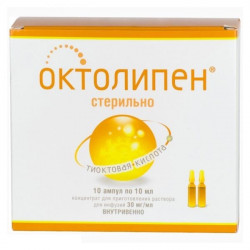



 All payments are encrypted via SSL
All payments are encrypted via SSL
 Full Refund if you haven't received your order
Full Refund if you haven't received your order
The active substance of the drug Octolipen®: Thioctic acid
Manufacturer: Pharmstandard Ufa
ATH codes for the drug Oktolipen®: A16AX01
For drugOctolipen highlighted the following importance:
Date of registration of the drug Oktolipen®: March 17, 2008
Registration data on the drugOctolipen:
DrugOctolipen prescription.
Concentrate for solution for infusion transparent, greenish-yellow color.
| 1 ml | 1 amp | |
| thioctic (α-lipoic) acid | 30 mg | 300 mg |
Excipients: ethylenediamine, disodium edetate (ethylenediaminetetraacetic acid disodium salt), water d / u.
10 ml - dark glass ampoules (5) - blister packs (2) - cardboard packs.
Metabolic agent is an endogenous antioxidant that binds free radicals.
Thioctic acid is formed in the body during the oxidative decarboxylation of alpha-keto acids. As a coenzyme of mitochondrial multienzyme complexes, it is involved in the oxidative decarboxylation of pyruvic acid and alpha keto acids.
It contributes to a decrease in blood glucose and an increase in glycogen content in the liver, as well as to overcome insulin resistance. By the nature of the biochemical action, thioctic acid is close to the B Vitamins. Participates in the regulation of lipid and carbohydrate metabolism, stimulates cholesterol metabolism, improves liver function.
® It has a hepatoprotective, hypolipidemic, hypocholesterolemic, hypoglycemic effect. Improves trophism of neurons and axonal conductivity, reduces the manifestations of diabetic and alcoholic polyneuropathy.
Suction
With a / in the introduction of Cmax makes 25-38 mkg / ml. AUC is about 5 μg × kg / ml. Vd - about 450 ml / kg.
Metabolism
Metabolized in the liver by side chain oxidation and conjugation.
Removal
Thioctic acid and its metabolites are excreted in the urine (80-90%). T1/2 - 20-50 min. Total plasma clearance is 10-15 ml / min.
- pregnancy;
- breastfeeding period;
- children's and teenage age up to 18 years (efficiency and safety of use are not established);
- hypersensitivity to the drug.
® should be administered in / in the drip 300-600 mg 1 time / day. within 2-4 weeks. In the future, switch to oral therapy.
For the preparation of an infusion solution, 1-2 ampoules (300 - 600 mg) of the drug are diluted in 50-250 ml of a 0.9% sodium chloride solution. The finished solution is injected into / in the drip.
The drug is sensitive to light radiation, so the ampoules should be taken out of the package just before use. It is advisable to protect the vial with the solution from light during the infusion (you can use light-protective bags, aluminum foil).
Prepared solutionOctolipen for IV injection should be stored in a dark place, the maximum storage time of the drug after preparation of the solution is 6 hours.
The use of the drug during pregnancy and during breastfeeding is contraindicated.
In patients with diabetes mellitus, especially at the beginning of drug treatment, frequent monitoring of glucose concentration in the blood is necessary. In some cases, a reduction in the dose of hypoglycemic agents is required.
During treatment it is necessary to strictly abstain from alcohol, because ethanol reduces the therapeutic efficacy of thioctic acid.
Symptoms:headache, nausea, vomiting.
Treatment:symptomatic. There is no specific antidote.
Thioctic acid (as an infusion solution) reduces the effect of Cisplatin.
With simultaneous use with insulin and oral hypoglycemic agents, there is an increase in the hypoglycemic effect.
Pharmaceutical Interaction
Thioctic acid forms hardly soluble complex compounds with sugar molecules. The prepared solution of the drug is incompatible with a solution of glucose, levulose, Ringer's solution, as well as with compounds (including their solutions) that react with disulfide and SH-groups.
The drug in the form of a concentrate for preparing a solution for infusion should be stored out of the reach of children at a temperature not higher than 25 ° C. Shelf life - 2 years.
Prepared solutionOctolipen for IV injection should be stored in a dark place, the maximum storage time of the drug after preparation of the solution is 6 hours.
Cardiovascular:very rarely - thrombophlebitis.
Nervous system:very rarely - seizures, diplopia, with rapid IV injection, an increase in intracranial pressure (a feeling of heaviness in the head), difficulty in breathing may occur.
Hemic and lymphatic:very rarely - thrombocytopathy.
Dermatologic:very rarely - hemorrhagic rash (purpura), point hemorrhages in the mucous membranes and skin.
Metabolism:symptoms of hypoglycemia (due to improved glucose uptake).
Allergic reactions:urticaria, systemic allergic reactions (including anaphylactic shock).
For the disappearance of these side effects additional therapy is not required.
